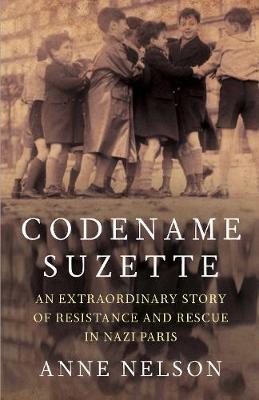in the histories of the Occupation. Subtitled ‘An extraordinary story of resistance and rescue in Nazi Paris’ this is the result of her search for Suzanne’s story. The daughter of a wealthy financier and married to the grandson of a Belgian prime minister, Suzanne was a member of the grande bourgeoisie with a country residence and a Paris apartment in the Palais Royal.

Paperback 336pp RRP: $29.99
Suzanne had Jewish friends, and when the first arrests of Jews took place in 1941, she began her association with the Jewish organisation Solidarité. In September 1941 the family moved to Paris where her apartment saw a succession of ‘maids’ awaiting forged papers. In the winter of 1941-1942 Suzette joined the MNCR (The National Movement Against Racism).
In January 1942 the Wansee Conference planned the total destruction of European Jews and events in France moved quickly: foreign Jews continued to be interned; in March the first Jews were deported to Auchwitz, and in the Grande Rafle (round-up) in July, thousands were arrested by French Police and herded into the Velodrome d’Hiver in appalling conditions before being moved to internment camps. The MNCR had warned of the Rafle without effect, and now, with many parents deported to the East, desperate efforts were made to save the children, many of who were in homes run by the UGIF (General Union of French Jews).
Suzette successfully urged the Church to issue a pastoral letter against the arrests and she became deeply involved in finding people who would hide and look after Jewish children, and also in obtaining the money necessary to support them. She usually left home at 6.00 am, travelling to villages near Paris where she would confess to the local priest, obtain ‘good addresses’ for rescued children and return home at midnight. There were some major rescues of children from UGIF homes where volunteers ‘kidnapped’ children, provided them with new clothes and identities and took them to ‘good addresses’ before they could be recovered by the police. With her status and access to funds, Suzette helped to build a financial enterprise to fund the support of rescued children, and her apartment became the location for meetings of resistance movements.
The November 1942 arrest of Leopold Trepper, an acquaintance, and a member of the Red Orchestra, placed Suzette in danger of betrayal and in 1943 she had to go underground and cease her work rescue work.
Codename Suzette is extremely readable and at the same time provides a brilliant description of the convoluted politics of the Jewish, Resistance and collaborationist groups in wartime France. The book contains numerous photographs, dramatis personae, endnotes, an extensive bibliography and an index. Both the historian and the casual reader will find it hard to put down.
Reviewed for RUSIV by Roger Buxton, November 2017
Contact Royal United Services Institute about this article.






